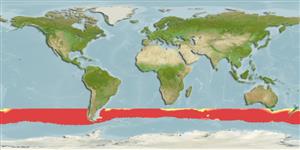>
Stomiiformes (Lightfishes and dragonfishes) >
Stomiidae (Barbeled dragonfishes) > Stomiinae
Etymology: Stomias: Greek, stoma = mouth; hard briddle (Ref. 45335).
More on author: Garman.
Environment: milieu / climate zone / depth range / distribution range
Ecologia
marino batipelagico; distribuzione batimetrica 200 - 1250 m (Ref. 5169). Temperate; 40°S - 62°S
Subtropical convergence and sub-Antarctic waters of the southern Hemisphere.
Size / Peso / Age
Maturity: Lm ? range ? - ? cm
Max length : 26.0 cm SL maschio/sesso non determinato; (Ref. 5169); 29.0 cm SL (female)
Life cycle and mating behavior
Maturities | Riproduzione | Spawnings | Egg(s) | Fecundities | Larve
Gon, O., 1990. Stomiidae. Scaly dragonfishes. p. 127-133. In O. Gon and P.C. Heemstra (eds.) Fishes of the Southern Ocean. J.L.B. Smith Institute of Ichthyology, Grahamstown, South Africa. (Ref. 5169)
IUCN Red List Status (Ref. 130435)
Threat to humans
Harmless
Human uses
Strumenti
Special reports
Download XML
Fonti Internet
Estimates based on models
Preferred temperature (Ref.
123201): 1.6 - 8.1, mean 6.2 °C (based on 212 cells).
Phylogenetic diversity index (Ref.
82804): PD
50 = 0.5010 [Uniqueness, from 0.5 = low to 2.0 = high].
Bayesian length-weight: a=0.00170 (0.00072 - 0.00400), b=3.22 (3.02 - 3.42), in cm total length, based on LWR estimates for this (Sub)family-body shape (Ref.
93245).
Trophic level (Ref.
69278): 4.1 ±0.7 se; based on size and trophs of closest relatives
Resilienza (Ref.
120179): Medio, tempo minimo di raddoppiamento della popolazione 1.4 - 4.4 anni (Preliminary K or Fecundity.).
Fishing Vulnerability (Ref.
59153): Low to moderate vulnerability (25 of 100).
